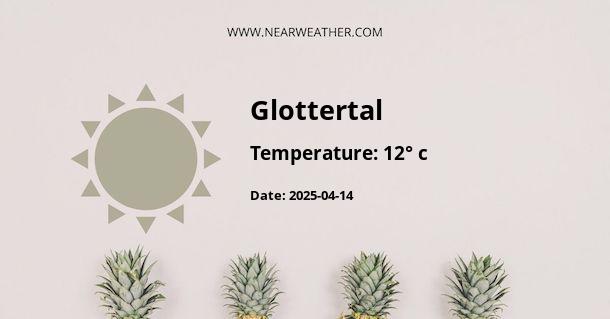Understanding Glottertal's Climate and Weather Patterns
Glottertal, a quaint town in the state of Baden-Württemberg, Germany, is nestled in the Black Forest region known for its illustrious landscapes and charming climate. When exploring the climate and weather of Glottertal, it is imperative to delve into the various elements that define its year-round conditions. The climate in this region can be categorized as a temperate oceanic climate, with nuances imparted by its proximity to the Rhine valley and the sheltering influence of the surrounding Black Forest.
Seasonal Climate Overview of Glottertal
In order to provide a comprehensive overview of the climate in Glottertal, we must examine the weather patterns seasonally, noting temperature variations, precipitation levels, and specific weather events that are characteristic of this region.
Spring in Glottertal
- Temperature: Spring temperatures gradually rise from an average low of 1°C in March to more comfortable highs around 18°C in May.
- Precipitation: Average rainfall increases from 60 mm in March to 100 mm by May, indicating a wetter end to the season.
- Weather Events: Late frost can occur, but the onset of spring brings blooming flora, accompanied by intermittent rain showers.
Summer in Glottertal
- Temperature: The summer months experience average highs ranging from 22°C to 25°C, with occasional spikes during heatwaves.
- Precipitation: Average monthly rainfall peaks in June and July with approximately 120 mm, featuring thunderstorms that are common during these months.
- Weather Events: Summer is the prime season for outdoor activities given the region’s ample sunshine and warm temperatures, although tourists should be prepared for sudden storms.
Autumn in Glottertal
- Temperature: Autumn witnesses a steady temperature decline, with averages dropping from 19°C in September to around 6°C in November.
- Precipitation: The season typically sees a dip in precipitation with averages around 60-80 mm per month.
- Weather Events: The foliage in the Black Forest provides a spectacular display, though the increasing winds and fading daylight mark the transition towards cooler days.
Winter in Glottertal
- Temperature: Winter often brings sub-zero temperatures, with averages between -2°C and 4°C, and snowfall is a common feature in this picturesque setting.
- Precipitation: Snowfall varies, but generally, the region accumulates moderate snow depths, with precipitation levels averaging 70-90 mm each month.
- Weather Events: Occasional snowstorms and persistent frosts can make for a winter wonderland, but also pose challenges for transportation and outdoor activities.
Monthly Climate Breakdown for Glottertal
| Month | Average High (°C) | Average Low (°C) | Precipitation (mm) |
|---|---|---|---|
| January | 3 | -2 | 46 |
| February | 5 | -1 | 43 |
| March | 9 | 1 | 60 |
| April | 14 | 4 | 64 |
| May | 18 | 8 | 100 |
| June | 22 | 12 | 123 |
| July | 24 | 13 | 118 |
| August | 24 | 13 | 113 |
| September | 19 | 9 | 81 |
| October | 14 | 6 | 76 |
| November | 7 | 2 | 66 |
| December | 4 | 0 | 59 |
Note: The data presented in the table is based on long-term historical averages and can be subject to change due to emerging climate patterns and variations.
Weather Influences and Microclimates
Glottertal's weather is not only impacted by the broader patterns of the temperate oceanic climate but also by its topographical features. The Black Forest acts as a barrier, shielding the town from harsh weather that can affect other parts of the region. The Rhine valley, to the west, contributes to warmer air currents that can occasionally lead to higher temperatures and lower precipitation in certain parts of the year.
The presence of microclimates within Glottertal itself cannot be overlooked. Variations in elevation and exposure to sunlight create pockets where the weather can differ significantly from the general patterns. For instance, south-facing slopes may experience earlier spring conditions due to increased solar radiation, while valley bottoms might be cooler and prone to frost.
Impact of Climate on Glottertal's Agriculture and Tourism
The climate of Glottertal has a direct influence on its local economy, particularly in the sectors of agriculture and tourism. The region's viticulture thrives during the warm, sunny periods, while the cool, moist conditions also promote the growth of certain crops unique to the area. The seasonal weather patterns support a variety of outdoor activities, from hiking and cycling in the milder months to skiing and snowshoeing in the winter. Glottertal’s climate thus plays a crucial role in attracting visitors seeking its natural beauty and outdoor experiences.
Adapting to Climate Variability
As climate change continues to influence weather patterns globally, Glottertal is not immune to its effects. The town and its inhabitants must be prepared to adapt to potential increases in extreme weather events, such as heatwaves and intense storms. Urban planning, agriculture, and infrastructure development must take into consideration the changing climate and incorporate sustainable practices to mitigate and adapt to these changes.
In conclusion, Glottertal's climate and weather conditions provide a rich tapestry of experiences throughout the year, though they come with their own set of challenges. By understanding and respecting these natural patterns, the residents and visitors of Glottertal can continue to enjoy the unique offerings of this enchanting Black Forest town.
A - Glottertal's Latitude is 48.049999 & Longitude is 7.933330.
A - Weather in Glottertal is 12° today.
A - Climate Conditions in Glottertal shows overcast clouds today.
A - Humidity in Glottertal is 94% today.
A - Wind speed in Glottertal is 4.21 km/h, flowing at 149° wind direction. today.
